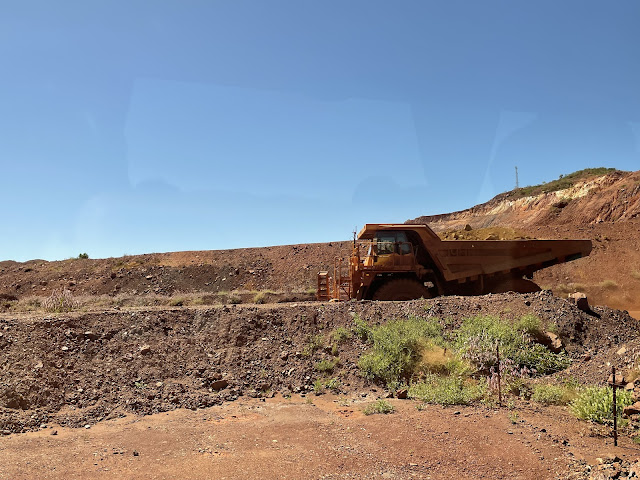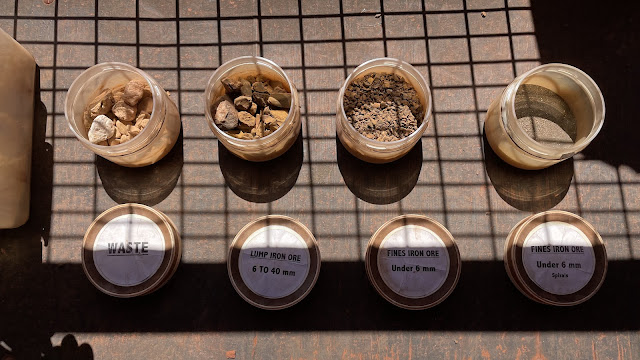I didn’t mention last time that the town of Tom Price has the highest elevation of any in Western Australia, at 747 metres. This is higher than Bathurst. I always thought of it as Mount Tom Price. That is actually the name of the mine, owned by Rio Tinto. There was a Mount Tom Price, but it has been mined away.
The morning after we arrived, we went on a guided tour of the mine site. We were popped in a bus and driven out to the site via a short town tour. One part of town houses the FIFO (fly in, fly out) workers, up to 600 at a time. Even our bus driver tour guide is a FIFO worker, not only doing tours, but other transport driving as well.
Firstly, we drove past the Heavy Duty Machinery Workshop, where they were working on a digger. That huge bucket made me think of the five metre wide bucket we had seen driving down the road a couple of days earlier. It’s hard to see the tyres, but each tyre costs $70,000! Apparently, there is enough steel in each of them to make three small cars.
We were taken to a lookout overlooking a huge old open cut pit. It has been fully worked out and is now used as a tailings dam. The black you can see on the far wall is black shale, which is rather volatile and dangerous to disturb, so that was also a reason they stopped mining here.
While we were there, a few “small” mining truck drove by.
All the roads are kept damp to suppress the dust. Even the water trucks are monsters.
The obligatory photo in our protective hats and glasses. Poor Mick, he has enough of this gear at work, without having to don it on holidays.
Next we were driven to the processing plant. Firstly, the ore is put through the primary crusher.
Then it is put on conveyers - really long ones.
Then it goes through more crushers, and washers and sorters………and I totally lost track……. There were so many building and conveyers and pipes. I can’t imagine how the blokes keep it all up and running, and they have to, as any down time costs them millions of dollars each day.
Anyway, it ends up in stockpiles.
Some is “lumps” - small rocks. Some is “fines”, like small blue metal and some is “spirals”, which is like fine sand.
It is then loaded onto railway trucks with this machine called a “reclaimer”.
Each train is 2.5 kms long and the total load is about 27,000 tonnes.
The funny thing was that there were a few cows grazing in among all the processing plant, as Rio Tinto has a cattle station surrounding the mine and there were wildflowers and butterflies. Such an unexpected thing to see.
There were so many facts and figures that I had no way of remembering them all. What I do remember is that the mine started production in 1962, which makes it 60 years old and they anticipate that it will continue production for another 70 years. Iron ore is currently selling at about $130 US per ton and costs about $18 US to produce. That is a pretty good profit margin. Rio Tinto has two iron ore mines, each with is own railway line. They ship our of Dampier, near Karratha, rather than Port Hedland.
It was really interesting seeing the mining side of things after having seen the port.
The mine tour was over by lunch time, so we headed out of town, firstly calling in to see the old mining truck sitting in a park. It worked from 1980 to 1992 and moved an estimated 23 million tonnes of ore during that time.
Just a tad taller than our van.
On our way we drove through the tiny town of Paraburdoo. Last year a new sculpture called “Resilience” was installed on the outskirts of town. Many community members assisted the artist Alex Mickle to create it. It is quite striking on that landscape.
Another item in town is an old mining truck. It looks like it has been painted up for the display, but no, that is the original colour.
It is all rather mind blowing, isn’t it.
It reminds me of when I was a kid, at about the time this truck commenced operation. The iron ore industry was just beginning and the huge trucks had to be transported from the eastern seaboard of Australia to the mines in the Pilbara. They were transported in two sections, one low loader truck with the cab and one with the tray. Bathurst has two bridges. The main one on the highway had metal lattice sides, so was too narrow for the trays, so they had to be taken over the “low level” bridge, just down from where I lived. It had a 5 ton weight limit and a bit of a steep hill once you had crossed the bridge. Well, they would take the cab across the highway bridge and park the trailer. Then the prime mover would attach to the front of the other prime mover and the two would tow the low loader with the tray section of the truck over the low level bridge and up the hill. It was all very exciting for us kids to watch. I digress…
We continued on our way until. We came to the free camp at Beasley River, which was rather a pleasant spot to spend the night. It is much more feasible to free camp now that the weather is cooling to pleasant temperatures in the mid 20s C.
The moon was nearly full and looked eerie though the trees and light cloud. The end of another enjoyable day.
The highlight of the day was the mine tour.




















6 comments:
Interesting reading. Did you really mean to say $1.30 US per ton of ore? That seems awfully cheap.
Really interesting! Many years ago Rio Tinto bought an open pit copper mine a couple of hours south of us. We have been to the overlook and visitor's center, but I don't know if there are tours that let you get closer. The trucks are ginormous, aren't they?
Love your moon shot.
What a massive operation. To see it reality must be amazing.
Very interesting to read about Mount Tom Price. My uncle used to work there many years ago.
Interesting tour, those mine trucks are huge!!
The size of the equipment is mind blowing.
Post a Comment